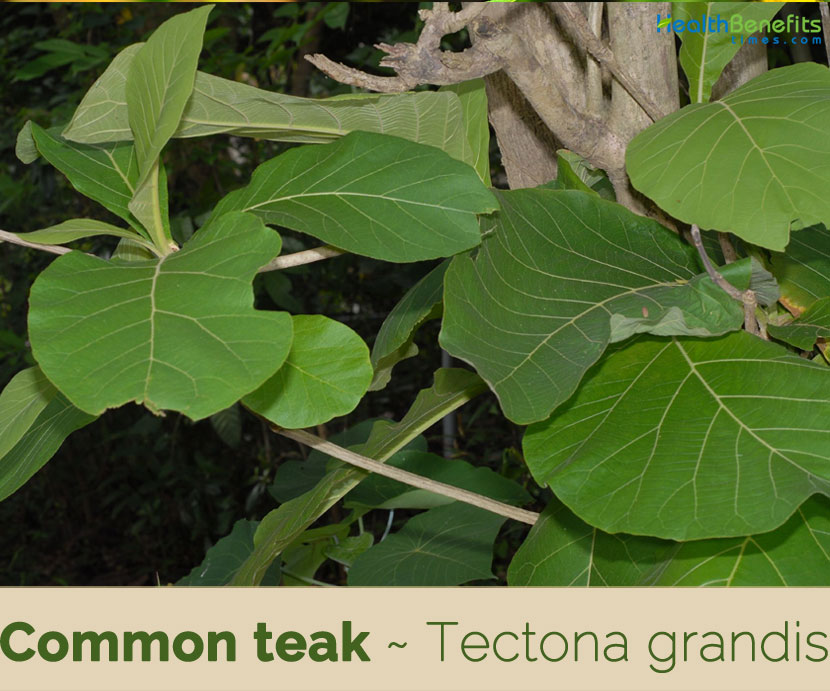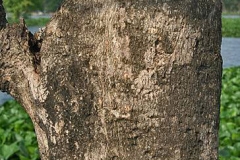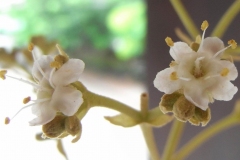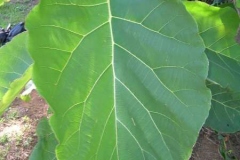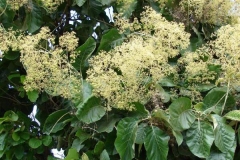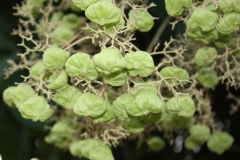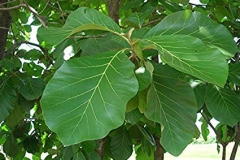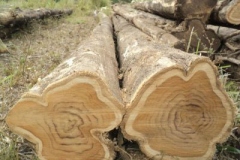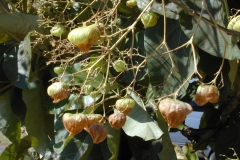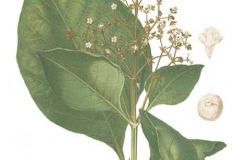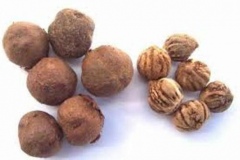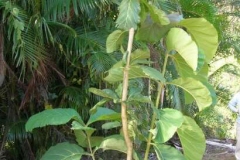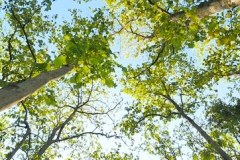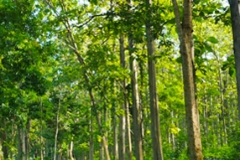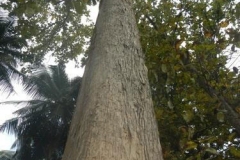| Common teak Quick Facts |
| Name: |
Common teak |
| Scientific Name: |
Tectona grandis |
| Origin |
South and southeast Asia, mainly India, Sri Lanka, Indonesia, Malaysia, Thailand, Myanmar and Bangladesh |
| Colors |
Pale green at first, then brown at maturity |
| Shapes |
Round woody globose drupe with four chambers, round, hard and woody enclosed in a inflated, bladder like green spongy covering and 1.2-1.8 cm in diameter |
| Taste |
Astringent, sweet, acrid |
| Health benefits |
Beneficial for Bronchitis, Treats of Anuria, Treats Headache, Treats Gastrointestinal Disorders, Beneficial for Haemoptysis, Supports Hair Growth, Wound Healing benefits, Overcome Anemia, Skin health |
Common Teak scientifically known as Tectona grandis is a tropical hardwood tree species placed in the flowering plant family Lamiaceae which includes fragrant Premna, as well as herbs like marjoram, basil, Holy basil, oregano, savory, thyme, lavender, lemon balm, bugle, motherwort, self-heal, wall germander, cat nip, ground ivy, Jupiter’s sage and hyssop and a whole host of other plants. Some forms of teak are known as Burmese teak, Central Province teak (CP teak), as well as Nagpur teak. The plant is native to south and southeast Asia, mainly India, Sri Lanka, Indonesia, Malaysia, Thailand, Myanmar and Bangladesh but is naturalized and cultivated in many countries in Africa and the Caribbean. The generic name comes from ‘tekka’, the Malabar name for T. grandis. The specific name, grandis, is Latin for large or showy. Few of the popular common of the plants are Teak, Bankok teak, Common teak, Indian oak, teak tree, teak wood, sagwan, Thaekku and thekku.
The tree is now planted in tropical to sub-tropical areas throughout the globe, not only for ornamental reasons but also in plantations for commercial timber production. Timber from this tree is an important tropical wood. Teak wood has a leather-like smell when it is freshly milled and is particularly valued for its durability and water resistance. The wood is used for boat building, exterior construction, veneer, furniture, carving, turnings, and other small wood projects. Teak wood is hard, durable, fine-grained, and resistant to decay if exposed to moisture and of attractive deep brown color. Teak wood is used in a variety of ways, including (a) for outdoor purposes, it is used in the manufacture of outdoor furniture, boat building, doors and window frames, and (b) for indoor purposes, and it is used for flooring, fine furniture and veneer. Teak is the national tree of Indonesia.
Plant Description
Common teak is a large, long, tropical, deciduous, hardwood tree reaching about 40–50 m tall. Bole is generally straight and branch less for up to 20 m and is up to 150(–200) cm in diameter and is often buttressed and may be fluted. In seasonal climates, the tree is deciduous, whilst trees grown in non-seasonal climates are semi-deciduous. The plant is found growing in mixed hardwood forests and normally prefers deep, well-drained, fertile alluvial-colluvial soil with a pH of 6.5 – 8 and a relatively high calcium and phosphorous content. Teak does not tolerate water logging or infertile lateritic soils. The root system is superficial, often no deeper than 50 cm, but the roots may extend laterally up to 15 meters from the stem. Twigs are stout, gray- brown, somewhat angled, lenticellate, initially covered in silvery to rusty pubescence; leaf scars nearly round to flat-topped. Bark is fibrous, grayish brown with shallow longitudinal fissures.
Leaves
Leaves are large, elliptic or obovate, 20 to 30 centimeters long, pointed at both ends, usually wedge-shaped at the base, with entire margins. Upper surface of leaves are rough and without hairs and the lower surface is densely covered with grey or yellowish hairs. Young leaves are red in color but become dark green at maturity.
Flowers
Flowers are numerous, short-stalked, and arranged in large, terminal, much-branched panicles 30 to 80 centimeters long. Calyx is small, broad, bell-shaped, and covered with stellate hairs, with sub-equal and spreading lobes. Whole calyx is ultimately enlarged, up to 2.5 centimeters long and forming a membranous, blade-like covering to the fruit. Corolla is white, smooth, less than 1 centimeter across, with sub-equal and spreading lobes. Flowering normally takes place from June to September. Pollination is done by insects like bees, flies and ants.
Fruits
Fertile flowers are followed by round woody globose drupe with four chambers, hard and woody enclosed in an inflated, bladder like green spongy covering and 1.2-1.8 cm in diameter, ripening in winter. Fruits are pale green at first, then brown at maturity. Each fruit may consist of 1 to 4 seeds. Seeds are ovoid 6 mm × 4 mm, without endosperm.
Health benefits of Common Teak
Listed below are some of the popular health benefits of consuming Common Teak
1. Skin health
Teak leaves are cooling in nature thus can act as an anti-inflammatory agent for reducing the inflammation of the skin. Leaves can be decocted or squeezed and used for preparing herbal medicines for treating skin diseases. Leaves can also help to tackle pruritus, which is a skin condition marked by severe itching of the skin.
Wood can be used for treating leucoderma, which is a cutaneous condition with localized loss of skin pigmentation that may occur after a series of inflammatory skin conditions, post-dermabrasion, burns or intralesional steroid injections have taken place. Leucoderma skin condition is mostly a cosmetic problem thus it is neither contagious nor infectious. Oil extracted from teak flowers can be used for treating scabies. Scabies is a transmissible skin disease symptomized by the itching of skin with small raised red spots, caused by the itch mite.
Bark can be used for treating leprosy. It is worthy to note that leprosy is a contagious disease that affects the skin, nerves and mucous membranes by causing discoloration and lumps on the skin. In severe cases, leprosy can lead to permanent disfigurement and deformities.
2. Overcome Anemia
Teak leaf extract is supposed to overcome anemia, this has been proven by several studies done by scientists Togo. Stating teak leaf extract tested on mice was able to increase the concentration of hemoglobin, platelets, and hematocrit and reticulocyte levels can increase endurance in young platelets.
3. Wound Healing benefits
Frontal leaves of teak can be prepared herbally and used for treating and healing wounds especially scald or burn wound. These researchers evaluated the effect of a hydrochloric extract of teak on experimentally induced wounds in rats. The models selected for the study were burn wound, excision wound, dead space wound and incision wound. An appropriate gel formulation was chosen for the application using cellophane membrane penetration.
An oral treatment with leaf extract produced a significant increase in the dry weight, breaking strength and hydroxyproline content of the granulation tissue in dead space wound. These researchers concluded that the oral (250 mg and 500 mg/kg body weight) or topical (5% and 10% gel formulation) application of teak leaf extract exhibit wound healing effects.
4. Supports Hair Growth
Oil extracted from teak flowers can be applied on hair for promoting hair growth. Additionally, another research reported that teak seeds are traditionally prepared and used as hair tonic mainly in the Indian system of medicine. Research was carried out to evaluate the petroleum ether extract of teak seeds and its effect on hair growth in albino mice. The 5.00% and 10.00% extracts added into simple ointment base were topically applied on the shaved denuded skin of albino mice.
5. Beneficial for Haemoptysis
Teak leaves can be used for treating haemoptysis. Haemoptysis is a health condition marked by the coughing up of blood.
6. Treats Gastrointestinal Disorders
Teak wood can be decocted and used for treating gastrointestinal disorders such as dysentery, stomach ache, piles and constipation.
7. Treats Headache
Studies reveal that the oil extracted from teak wood can be applied on the forehead for relieving headache. This is credited to the analgesic properties of this plant.
8. Treats of Anuria
Roots of the teak plant can be decocted and used for treating anuria. Anuria is a health condition marked by the failure of the kidneys to produce urine.
9. Beneficial for Bronchitis
Research revealed that teak flowers are useful for curing bronchitis. Bronchitis is the inflammation of the mucous membrane in the bronchial tubes, which causes broncho-spasm and coughing.
Traditional uses and benefits of Common Teak
- Water from soaking the bark overnight is given for white vaginal discharge.
- Liquid from soaking bark powder in warm water is ingested for chronic diarrhea.
- Paste made from ground bark is applied topically to relieve bloating and edema related to gall bladder problems.
- Paste made from ground bark powder mixed with cashew nut oil, is also applied topically to relieve inflammation.
- Paste made from the ground bark, ground charcoal, and rice cooking water, is applied repeatedly to treat herpes.
- Bark, Wood, Fruit are used to reduce phlegm, cure gonorrhea, treat leprosy, alleviate bloating, and stop hemorrhaging.
- Pulverized wood is used on swellings.
- Paste, made by grinding the fruit with cooking oil, is used to alleviate itching and rashes.
- Paste, made by grinding the fruit with rice washing water, is applied topically to clear clogged milk glands.
- Finely crushed fruit is cooked, applied as a poultice over the navel, and bound there with a cloth to treat urinary problems.
- Oil of fruit is used as a remedy for skin diseases.
- Root is used to treat urinary discharges.
- Wood tar paste is made from the powdered wood by putting it into hot water.
- Wood powder is vermifuge and promotes digestion and is effective in relieving bilious headaches and tooth aches, reduces inflammations or eruptions of the skin.
- Charred wood, soaked in poppy juice and made into a paste, has been used to relieve the swelling of the eyelids.
- Wood has been used as a hair tonic.
- Oil extracted from the roots is used to treat eczema, ringworm and inflammation.
- Bark has been used as an astringent and in the treatment of bronchitis.
- Flowers are diuretic and are used to treat biliousness, bronchitis and urinary disorders.
- Seeds are diuretic.
- Leaves have a reputation of being diuretic, depurative, purgative, stimulant, anti-dysenteric and vermifuge.
- Leaves are used in traditional medicine to treat anemia, asthenia, fever and malaria, amoebiasis, schistosomiasis and tuberculosis.
- Extracts of the leaves are reported to be effective against myco-bacterium tuberculosis, to treat bleeding of larynx, trachea, bronchi, or lungs, and sore throat.
- Oil extracted from the tender shoots is used against scabies in children.
- Wood is useful in the treatment of piles, leucoderma and dysentery.
- Flowers are an effective cure for bronchitis, biliousness and urinary discharges.
- Leaf extracts are effective against Mycobacterium Tuberculosis.
- It treats bleeding of larynx, trachea, bronchi or lungs and sore throat.
- Oil extracted from the flower of Teak promotes Hair growth.
- Oil is also useful in treating scabies, eczema, ringworm and inflammation.
- Wood is good for headache, burning sensation, pain and liver related problems.
- Roots are useful in the treatment of Urinary problems.
- Bark of Teak is astringent and treats bronchitis.
- Decoction of the root is given in anuria.
- Infusion of the flowers is given to take care of bronchitis and congestion of the liver.
- Decoction of the bark will take care of all the disorders listed in section three of medicinal use.
- Oil from the flowers and seeds is useful in checking scabies.
- Decoction of fresh or dried leaves used for menstrual disorders and hemorrhages in Philippines.
- Decoction of leaves, fresh or dried, used for hemoptysis.
- Decoction of leaves, fresh or dried, used as a gargle for sore throat.
- Decoction of fallen yellow leaves used for anemia.
- Hindus used the plaster of powdered wood for bilious headaches and for dispersion of inflammatory swellings.
- Charred wood in poppy juice, reduced to a smooth paste, is used for eyelid swelling. Also, believed to strengthen the sight.
- Paste of powdered wood applied for acute dermatitis; especially, that due to contact with caustic oleoresin of Anacardium occidentale.
- Oil of nuts applied to the scalp for hair growth; also, for soothing skin itching.
- It is used as laxative and in treatment of skin diseases and diarrhea in Cameroon.
Culinary uses
- Red dye obtained from boiling the wood shavings of the tree has been used to color Easter Eggs.
- Leaves are used in the preparation jack fruit dumpling in India.
- In Java, Indonesia, leaves are used in the preparation of gudeg, a dish of young jackfruit, providing the dish with a dark brown color.
Qualities of Teak Wood
Durable
Teak wood is very strong and highly durable, which means that it is long-lasting, thus, can withstand wear, pressure, or damage. Teak wood is marked by its high density and as such does not easily get damaged or decay. Teak wood can also withstand water, moisture and adverse weather conditions. Teak wood furniture can last for a very long period of time, thus if you don’t want to keep wasting money on cheap soft furniture, always buy teak wood furniture as it can last for even more than hundred years.
Easy Maintenance
Teak wood furniture is very easy to clean and maintain.
Strong Resistance to Insects and Termites Attacks
Teak consists of powerful oils that give the wood a very high resistance to insects, fungi and termites attacks.
Attractive
Teak wood is distinguished by its rich golden-brown color, which gives it an attractive appearance and outlook.
Supports the Ecosystem
Teak plant supports our ecosystem by beautifying the environment, ventilating the atmosphere and preventing erosion.
Teak Wood Furniture – Advantages and Disadvantages
Whether it is for furniture or flooring, teak wood has been a preferred solid wood material since many long years. Let’s take a look at the advantages and disadvantages of teak wood.
Benefits of using Teak Wood
1. Aesthetic appeal
Teak wood has a very attractive looking straight grain pattern coupled with a rich golden-brown color. In addition to this teak wood furniture also feels great to the touch, when compared with the newer engineered wood alternatives such as Particle boards, MDF and even plywood.
There are other hardwoods which are nearly as strong as teak, but it’s mainly because of its beauty that teak wood is so popular all over the world.
2. Quite Strong
Teak wood is a hardwood obtained from broad leaved deciduous trees, and it is remarkably strong, not only when compared to softwoods such as Mango wood or Pine wood, but also when compared with most of the other hardwood species of trees.
3. Very Durable
With proper care, teak wood furniture lasts for many long years (in many cases over 100 years). This is the reason why we still find antique teak pieces around. If you wish to buy furniture that will serve you, your children and then your grandchildren, then the best option is to go for teak wood furniture. Compare this longevity with particle board furniture which lasts only 2 to 3 years. This is because particle boards are not as strong and often get damaged while relocating or because of water. Durability can be counted as one of most significant advantage that teak wood offers.
4. Natural resistance to termites and insects
Teak wood has a natural oil content that resists termites (white ants), fungal stains, and also repels other insects that can destroy wood. Anyone who has ever had termites climbing on walls all over the house, and eating all the expensive wooden furniture before, will readily promise for how important this benefit is. This termite and insect resisting quality in turn increases the life span of wood, and is the reason why teak wood is superior compared to many other wood species.
5. Heat moderation
Teak wood like all other solid wooden furniture moderates heat. What this means is that it does not become too hot or too cold in the hot summers or the cold winters even when exposed to the elements. Though most people do not explicitly notice this particular quality of wood, it is one of the reasons why people instinctively like the touch and feel of natural wood furniture compared to its plastic or metal counterparts.
6. Resists rot and decay
Teak wood has a very high density, and does not rot or decay easily. This is the reason why it is so durable. Teak wood also has a natural resistance to several alkaline and acidic substances. Hence it does not get spoiled or stained easily.
7. High dimensional stability
Properly seasoned teak wood furniture does not warp or shrink too much. It retains its dimensions and is a stable material. Seasoning of wood involves drying the timber logs obtained from trees, so as to reduce its moisture content. Well-dried wood is not easily affected by climate changes.
8. Moisture-resistant
Teak wood has a good resistance to moisture and water. Other than its beauty, this is the reason why it is the preferred wood material used in ship-building for making the wooden flooring and decks. Because of its moisture resistance, teak wood is well suited for making indoor furniture as well as high quality garden furniture.
9. Can be hand-carved
From a carpenter’s or artisan’s point of view, teak is a fantastic material to work with, because unlike engineered wood products such as Particle boards, MDF or plywood, it can be hand-carved to increase its beauty. Most of the antique teak wood furniture often has interesting design patterns or shapes carved into the wood surface. Teak wood can be also be easily sawn and cut to desired sizes to make customized pieces of teak wood furniture as per client’s requirements.
10. Goes well with iron and other metals
Wood and metal are used a lot in combination. E.g. consider the table-mounted sewing machines of olden days, or the nails that are used in woodworking. It is important that the metals should not corrode or rust because of the wood. Though we cannot see it, woods are continually reacting to the environmental changes, and balancing their moisture content with the ambient moisture. What this means is that if the atmosphere is dry, the wood gives out moisture. And when such moisture comes in contact with metals it can be the cause of corrosion. Teak wood does not have this disadvantage, and has a good compatibility with iron and other metals.
11. Quite heavy
Teak wood is a very dense wood and has a high weight to volume ratio. This can be considered a beneficial trait, because a very basic rule in woodworking is that the denser and heavier a wood is, the stronger it will be. In addition to this most people have a distinct preference towards heavy and sturdy pieces of furniture, when it comes to buying solid wood furniture.
Disadvantages of Teak wood:
1. Very Expensive
This is the major drawback of teak wood is that it is very costly. The reason for this is the declining natural resources over the years. Demand is as high as ever, but supply has reduced. Other than the natural old-growth teak wood in forests, teak plantations (farms) have also flourished over the past years to try and meet this high demand.
Price of teak wood logs is indicated as per cubic feet price, and it is much higher compared to buying plywood. Add to this the payments required to be made to artisans for making a customized piece, or the commissions that dealers earn in the case of buying readymade teak wood furniture. It all adds up to the costs.
2. Hard to find high-quality wood
High quality and genuine teak wood is hard to identify for customers since it needs some knowledge and experience about woods. Perhaps the easiest way to fix this issue is to get suggestions and help from a trusted and reliable source.
3. Woodworking Tools get blunted
Teak is a hard material. From a carpenters point of view it presents a minor problem since the woodworking tools become blunt and need to be sharpened while working on the wood.
4. Needs care (needs to be polished once in every couple of years)
Compared to decorative laminates over plywood, solid teak wood furniture needs more care and maintenance. It needs to be polished every couple of years to maintain its beauty. There are different kinds of polish available called lacquer, but the easiest way is perhaps to use Touch Wood polish from Asian Paints that is specifically made for giving shine to wooden surfaces.
Other Facts
- Both the root bark and the young leaves produce a yellowish-brown or reddish dye, which is used for paper, clothes and matting.
- Dye from the leaves prevents the blackening of yama after they are cooked.
- Leaves are used for packing food products in the markets.
- Oil extracted from the seeds promotes hair growth.
- Sawdust from teak wood is used as incense in Java; the dust, however, may irritate the skin.
- Sawdust is also used to produce active carbon.
- Heartwood is often dull yellowish when freshly cut but turns golden brown or sometimes dark grayish-brown after exposure, often streaked grey or black.
- Wood is oily to the touch and when freshly cut has a smell reminiscent of leather.
- Wood is a medium weight timber that is rather soft; it is durable to very durable, with an average service life in contact with the ground of more than 10 years under tropical conditions and more than 25 years under temperate conditions.
- In house building, teak wood is particularly suitable for interior and exterior joinery (windows, solid panel doors and framing) and is used for floors exposed to light to moderate pedestrian traffic.
- It is also used quite extensively for garden furniture.
- Other uses are for building poles, transmission line poles, fence posts, wall boards, beams, woodwork, boxes, musical instruments, toys, railway sleepers and railcar construction.
- It is brittle and thus less suitable for articles requiring high resilience, such as tool handles and sporting goods.
- Its high resistance to a wide variety of chemicals makes it ideal for laboratory and kitchen tables as well as for scrubbing towers, vats, pipes and fume ducts in industrial chemical plants.
- Wood grains are figured well, producing an attractive veneer, which is extensively used in the manufacture of furniture and interior fittings.
- Teak wood is appropriate for the manufacture of decorative plywood.
- Larger logs are utilized for beams and sleepers, smaller ones for scantlings and battens, and thinner top ends and poles are used as round posts.
- Thinning is also used for timber.
- For the export market, teak wood is recommended for ship decking and other constructional work in boat building.
- Teak wood has been used in the manufacture of charcoal and as fuel wood, but nowadays it is usually considered too valuable for anything but pruning remnants and other rejects to be used in this way.
- Indonesia is the world’s leading producer of teak and its importance to their economy has helped to sustain replanting program.
- Young plants show a remarkable capability to recover after fire.
- There is 1 000-3500 fruits/kg.
- Leaves are occasionally used as plates for dining purposes, for making cheap umbrellas and for thatching temporary huts in some places.
References:
https://www.itis.gov/servlet/SingleRpt/SingleRpt?search_topic=TSN&search_value=32247#null
https://davesgarden.com/guides/pf/go/135755/
https://npgsweb.ars-grin.gov/gringlobal/taxonomydetail.aspx?id=80123
https://pfaf.org/user/Plant.aspx?LatinName=Tectona+grandis
https://www.cabi.org/ISC/datasheet/52899
http://www.missouribotanicalgarden.org/PlantFinder/PlantFinderDetails.aspx?taxonid=287459&isprofile=0&
https://plants.usda.gov/core/profile?symbol=TEGR
https://en.wikipedia.org/wiki/Teak
http://luirig.altervista.org/schedenam/fnam.php?taxon=Tectona+grandis
http://dendro.cnre.vt.edu/dendrology/syllabus/factsheet.cfm?ID=1104
http://www.theplantlist.org/tpl/record/kew-202018
https://indiabiodiversity.org/species/show/31257
https://gd.eppo.int/taxon/TCTGR
http://www.worldagroforestry.org/treedb/AFTPDFS/Tectona_grandis.PDF
http://www.frienvis.nic.in/WriteReadData/UserFiles/file/pdfs/Teak.pdf
http://www.flowersofindia.net/catalog/slides/Teak.html
https://uses.plantnet-project.org/en/Tectona_grandis_(PROTA)
https://www.hort.purdue.edu/newcrop/CropFactSheets/sagon.html
Comments
comments


